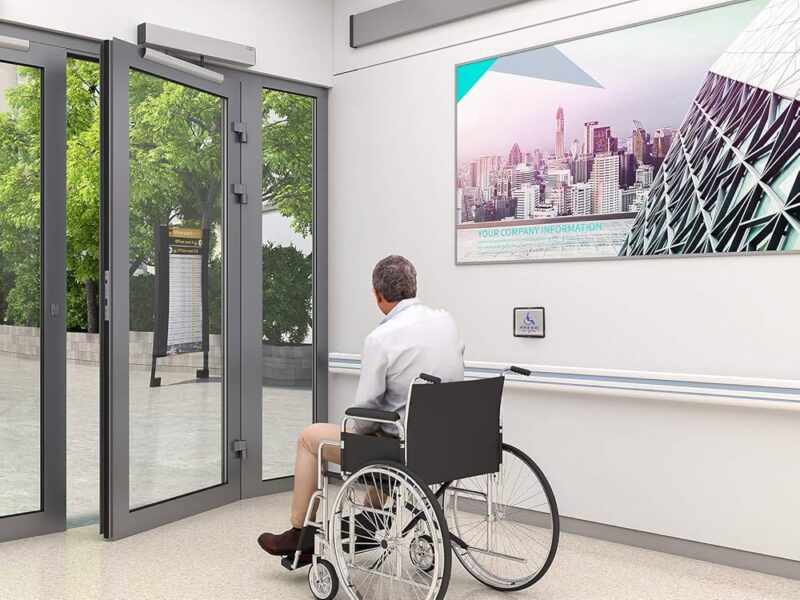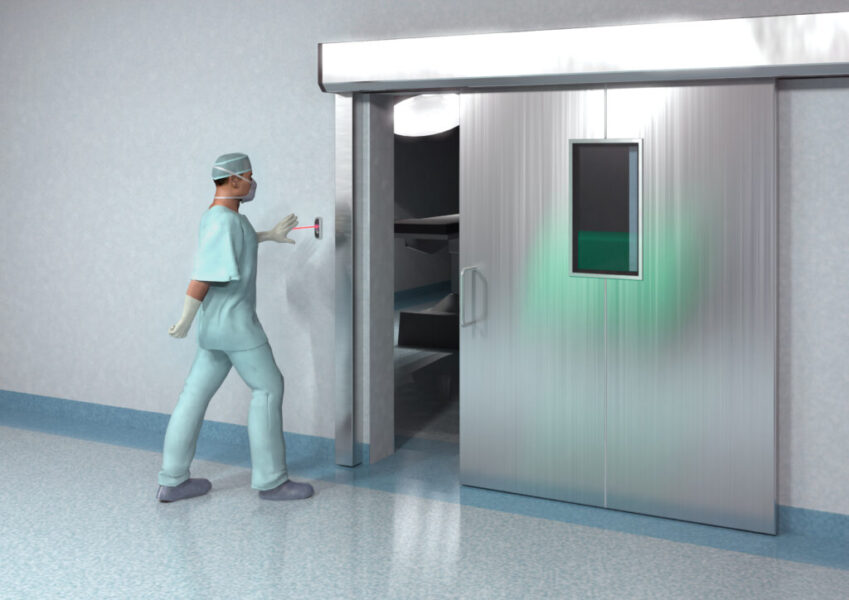Why Automatic Touchless Doors Are Critical for Hospitals in Australia
Touchless doors are now essential in Australian healthcare because they help prevent the spread of germs by reducing physical contact with door surfaces. Hospitals, clinics, and aged care centres use automatic doors to improve hygiene, support infection control, and comply with strict safety regulations. These systems provide hands-free access for staff, patients, and visitors—making healthcare environments cleaner, safer, and more accessible.
This article explores the crucial role of touchless doors in healthcare settings across Australia, discussing their benefits, compliance with health standards, common applications, and future developments. If you are managing or building a healthcare facility in Australia, this guide will show why integrating touchless door systems is no longer optional—it’s essential.
Table of Contents
ToggleWhat Are Touchless Doors and How Do They Work?

Touchless doors, also known as automatic or sensor-activated doors, operate without physical contact. They typically use technologies such as:
- Infrared or microwave motion sensors
- Push-to-open proximity sensors (elbow or foot-activated)
- RFID or Bluetooth-enabled access
- Facial recognition or voice command systems (in advanced setups)
When someone approaches or activates a sensor, the door opens automatically. This eliminates the need to touch door handles, which are common points of cross-contamination.
Why Is Hygiene So Important in Australian Healthcare Facilities?
Infection control is a top priority in healthcare, and Australia is no exception. According to the Australian Commission on Safety and Quality in Health Care (ACSQHC), healthcare-associated infections (HAIs) affect 1 in 10 patients admitted to Australian hospitals. High-touch surfaces, such as door handles and push plates, significantly contribute to the spread of pathogens.
Touchless doors break the chain of contact transmission by eliminating one of the most frequently touched surfaces in any healthcare setting. By reducing touchpoints, healthcare facilities can:
- Lower the risk of pathogen transmission
- Meet higher hygiene benchmarks
- Improve public perception and trust in facility safety
With COVID-19 amplifying concerns about airborne and surface-level infections, Australian healthcare providers are more driven than ever to adopt proactive infection prevention methods.
Key Benefits of Touchless Doors in Healthcare Settings
1. Infection Control
Touchless doors help stop the spread of viruses, bacteria, and other pathogens. Particularly in intensive care units (ICUs), isolation rooms, operating theatres, and emergency departments, minimizing contact is vital.
2. Hands-Free Access for Staff and Patients
Medical staff often need to move through spaces without using their hands—they may be pushing a gurney, holding sterile instruments, or assisting patients. Touchless doors provide seamless access, improving workflow and safety.
3. Enhanced Accessibility
Many patients—especially those who are elderly, disabled, or using mobility aids—struggle with traditional doors. Automatic doors equipped with wide openings and smooth, contactless operation ensure compliance with the Disability Discrimination Act (DDA) and AS 1428.1 accessibility standards.
4. Energy Efficiency
Advanced touchless doors can be programmed to open and close with precision, reducing air leakage in climate-controlled areas. Revolving or sliding automatic doors in entrances help maintain indoor temperatures, contributing to energy cost savings.
5. Staff Productivity
Staff no longer need to open doors manually or use elbows or feet—methods that are not only inconvenient but also unsanitary. With faster, easier movement throughout the building, healthcare professionals can focus on patient care instead of navigating physical barriers.
6. Patient Experience and Perception
Cleanliness and efficiency leave lasting impressions. Patients and visitors equate touchless technology with modern, high-quality care. In competitive healthcare markets like Melbourne and Sydney, first impressions matter.
What Are the Key Standards for Touchless Doors in Australia?
When integrating touchless doors, healthcare facilities in Australia must comply with several regulatory standards:
1. Australian Standard AS 5007:2022
Specifies requirements for the design, installation, and testing of automatic pedestrian doors. Ensures safety of operation, especially in emergency scenarios.
2. AS/NZS 3000 (Wiring Rules)
Relevant for any sensor or electric operator installations, particularly in wet areas like hospitals.
3. AS 1428.1 (Accessibility)
Ensures buildings are accessible to people with disabilities, including door dimensions, clearance times, and ease of use.
4. Infection Control Guidelines
Set by the National Health and Medical Research Council (NHMRC), these reinforce the importance of minimising touchpoints in high-risk environments.
Failing to comply with these standards can result in legal liabilities and safety risks.
Common Areas in Healthcare Where Touchless Doors Are Critical

1. Main Entrances and Emergency Access Points
Provide quick, unimpeded access for ambulances, wheelchairs, or stretchers.
2. Intensive Care Units (ICUs) and Operating Theatres
Minimise contact before and after sterile procedures. Integrated with security systems for controlled access.
3. Isolation Rooms and Infectious Disease Wards
Touchless doors reduce the chance of cross-contamination between infected and non-infected zones.
4. Bathrooms and Staff Rooms
High-risk areas due to moisture and surface contact. Elbow or foot-activated sensors are common.
5. Aged Care Facilities and Rehab Centres
Improve accessibility for elderly residents and staff assisting them.
How to Choose the Right Touchless Door System?
Types of Doors:
- Sliding Doors: Ideal for main entries, corridors, and high-traffic zones.
- Swing Doors: Suitable for internal rooms, labs, or treatment spaces.
- Telescopic Doors: Maximise clear opening width in narrow hallways.
- Revolving Doors: Improve energy efficiency at public entry points.
Sensor Options:
- Motion sensors (infrared or microwave)
- Push-to-open plates (elbow or foot)
- RFID card readers or wristbands for staff-only access
- Bluetooth or smartphone integration
Material Considerations:
- Stainless steel or antimicrobial coated finishes
- Double-glazed or tempered glass for entrances
- Fire-rated materials in critical zones
Challenges and Solutions in Implementation
Retrofitting Older Buildings
Many Australian healthcare facilities are decades old. Retrofitting can involve structural reinforcements, rewiring, and ensuring door frames meet accessibility standards. Partnering with an experienced installer is crucial.
Power Supply & Backup
Touchless doors require stable power. Hospitals must integrate them with backup power systems to ensure uninterrupted access during outages.
Cost Considerations
Initial investment can be high, especially with advanced sensors or fire-rated components. However, long-term savings in energy, infection control, and labour make them cost-effective over time.
The Future: Smart Touchless Entry in Australian Healthcare
As IoT and smart infrastructure evolve, we can expect:
- Doors integrated with real-time occupancy and air quality monitoring
- AI-based traffic pattern analytics to optimise door operation
- Facial recognition access for restricted areas
- Voice command access for staff wearing gloves or PPE
Touchless doors will not only serve hygiene but become an integral part of smart, responsive hospital infrastructure.
FAQs: Touchless Doors in Australian Healthcare
Are touchless doors required in Australian hospitals?
Not legally required in all areas, but strongly recommended in high-risk zones like ICUs and isolation wards. They help facilities comply with infection control and accessibility standards.
Do touchless doors meet NDIS and accessibility requirements?
Yes. When designed to meet AS 1428.1, touchless doors support disability access and align with the Disability Discrimination Act (DDA).
Can older hospitals install touchless door systems?
Yes. With professional assessment, most buildings can be retrofitted with sliding or swing touchless systems. Some structural adjustments may be needed.
Are touchless doors secure for staff-only areas?
Yes. You can use RFID, Bluetooth, or facial recognition access for restricted entry points. These options integrate with existing hospital security systems.
What’s the average cost of installing touchless doors in Australia?
Prices vary by size, type, and sensor technology. Basic installations start around $3,000–$5,000 per door, with advanced features costing more.
Final Thoughts: A Non-Negotiable Investment for Australian Healthcare
Touchless door technology is no longer futuristic. In Australia’s healthcare landscape—where infection control, accessibility, and efficiency are critical—these systems are indispensable.
Healthcare administrators, facility managers, and architects should view automatic, sensor-activated doors not as upgrades but as essential features in both new constructions and retrofits. Beyond meeting Australian Standards and improving safety, touchless doors are a statement: that your facility is ready for the future of healthcare.
Need help choosing or installing touchless doors in your facility?
Talk to a local certified provider who understands Australian compliance and hospital-grade systems.
At Digital Home Systems (DHS), we specialise in supplying and installing high-quality automatic door systems for healthcare, residential, and commercial environments across Australia. With expert knowledge of Australian standards and a commitment to smart technology, DHS provides tailored solutions that improve hygiene, accessibility, and energy efficiency. If your facility needs a trusted partner for touchless entry solutions, visit digitalhomesystems.com.au to explore our services or get a customised quote.
Explore our range of door products.
